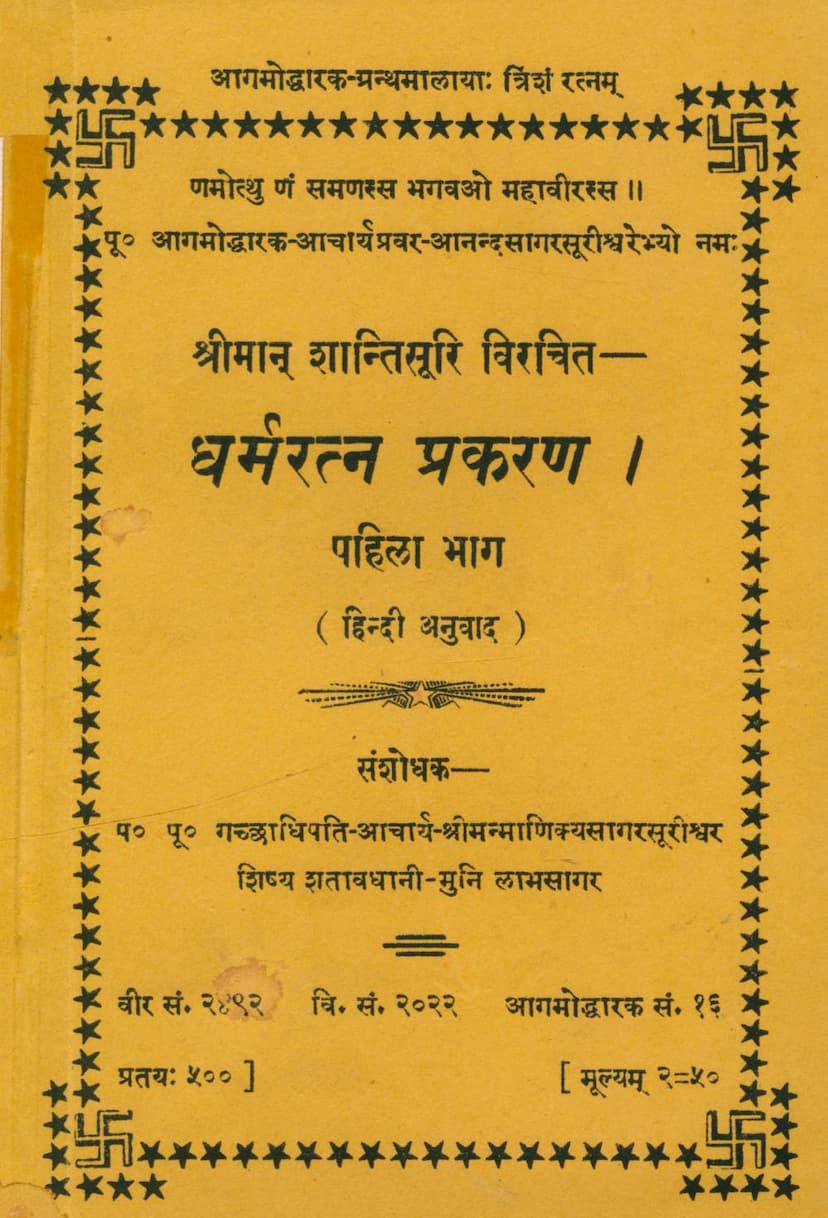Dharmratna Prakaran Part 01
Added to library: September 1, 2025

Summary
Here's a comprehensive summary of "Dharmaratna Prakaran Part 01" by Shantisuri and Labhsagar, based on the provided text:
Overall Purpose:
"Dharmaratna Prakaran Part 01" is a Jain text presented in Hindi, authored by Shantisuri and translated/edited by Muni Labhsagar. Its primary aim is to guide individuals, particularly young ones, towards a life of spiritual devotion by cultivating twenty-one noble virtues. The book emphasizes that understanding and practicing these virtues are essential for achieving ultimate spiritual liberation (moksha).
Key Themes and Content:
The book begins with traditional Jain invocations and dedications. The core of the text focuses on elaborating on the twenty-one virtues that make an individual worthy of attaining the "Jewel of Dharma" (Dharmaratna).
The Twenty-One Virtues and Their Elaboration:
Each virtue is presented with a descriptive name and then illustrated through engaging stories. These stories serve as parables, making the abstract concepts of virtues relatable and memorable, especially for children. The virtues discussed (as indicated in the table of contents) include:
- Akshudrata (Non-petty-mindedness/Generosity): Described as being not small-minded but rather of broad disposition.
- Roopvaan (Handsome/Well-formed): Discusses possessing pleasing physical attributes.
- Prakriti Saumya (Naturally Gentle/Peaceful): Highlights a calm and mild temperament.
- Lokapriya (Beloved by People): Emphasizes qualities that make one likable and respected by others.
- Akroor (Non-cruel/Kind): Focuses on refraining from cruelty and being compassionate.
- Bhiru (Fearful of Sin): Stresses the importance of being conscious of and avoiding sinful actions.
- Ashath (Non-deceitful/Honest): Underscores honesty and transparency in dealings.
- Sudakshinya (Beneficent/Kind-hearted): Points to a disposition of helping others.
- Lajjalu (Modest/Shy of Wrongdoing): Encourages a sense of shame in performing bad deeds.
- Dayalu (Compassionate): Highlights having empathy and kindness towards all living beings.
- Samyadrushtitva (Righteous View/Equanimity): Discusses having a balanced perspective and avoiding partiality.
- Gunnuragitva (Appreciative of Virtues): Emphasizes valuing and appreciating good qualities in others.
- Satkatha (Virtuous Discourse/Good Speaking): Promotes engaging in meaningful and righteous conversations.
- Supakshatva (Having a Good Family/Well-supported): Refers to having a supportive and virtuous family environment.
- Dirghadarshitva (Farsightedness/Prudence): Stresses the importance of foresight and considering long-term consequences.
- Visheshajnya (Discerning/Expert): Highlights the ability to understand nuances and make wise judgments.
- Vriddhanugatva (Following the Elderly/Wise): Encourages learning from and respecting the advice of elders and wise individuals.
- Vinaya (Humility/Politeness): Emphasizes being humble and respectful in conduct and speech.
- Krutajnya (Grateful): Stresses the importance of acknowledging and reciprocating kindness.
- Parahitarthata (Working for the Welfare of Others): Highlights selflessness and acting for the benefit of humanity.
- Labdhalakshya (Achieved Objective/Skillful): Refers to being competent and achieving one's goals with skill.
Illustrative Stories (Examples):
The text is rich with stories that exemplify each virtue. For instance:
- Pashupal ki Katha (Story of the Shepherd): Likely illustrates the importance of recognizing true value and not being easily deceived (potentially related to Akshudrata or foresight).
- Som ki Katha (Story of Som): Likely illustrates the virtue of Akshudrata.
- Sujat ki Katha (Story of Sujat): Probably illustrates the virtue of Roopvaan.
- Vijaykumar ki Katha (Story of Vijaykumar): Appears to illustrate Prakriti Saumya and Lajjalu virtues.
- Kirtichandra Raja ki Katha (Story of King Kirtichandra): Likely illustrates Akroor (non-cruel) virtue.
- Vimal ki Katha (Story of Vimal): Possibly illustrates Bhiru (fearful of sin) virtue.
- Chakradeva ki Katha (Story of Chakradeva): Appears to illustrate Ashath (non-deceitful) virtue.
- Kshullakkumar ki Katha (Story of Prince Kshullak): Likely illustrates Sudakshinya (beneficent).
- Yashodhar ki Katha (Story of Yashodhar): Seems to illustrate Dayalu (compassionate).
- Somvasu ki Katha (Story of Somvasu): Likely relates to Samyadrushtitva (equanimity).
- Purandar Raja ki Katha (Story of King Purandar): Probably illustrates Gunnuragitva (appreciative of virtues).
- Rohini ki Katha (Story of Rohini): Likely illustrates Satkatha (virtuous discourse).
- Bhadranandi Kumar ki Katha (Story of Prince Bhadranandi): Possibly relates to Supakshatva (good family).
- Dhan Shreshthi ki Katha (Story of Merchant Dhan): Illustrates Dirghadarshitva (farsightedness).
- Subuddhi Mantri ki Katha (Story of Minister Subuddhi): Likely illustrates Visheshajnya (discerning).
- Madhyam Buddhi ki Katha (Story of Moderate Intelligence): Appears to illustrate Vriddhanugatva (following the wise).
- Bhuvanatilak Kumar ki Katha (Story of Prince Bhuvanatilak): Likely illustrates Vinaya (humility).
- Vimal Kumar ki Katha (Story of Prince Vimal): Possibly illustrates Krutajnya (grateful).
- Bhim Kumar ki Katha (Story of Prince Bhim): Seems to illustrate Parhitarthata (welfare of others).
- Nagarjun ki Katha (Story of Nagarjun): Illustrates Labdhalakshya (skillful).
- Prabhas ki Katha (Story of Prabhas): Likely relates to the importance of a pure foundation for good qualities.
Structure and Pedagogy:
The book employs a pedagogical approach by:
- Starting with Foundational Concepts: Explaining the purpose of the text, the nature of Dharma as a jewel, and the necessity of guru's guidance.
- Using Stories for Illustration: Each virtue is reinforced with a narrative, making the teachings practical and memorable.
- Providing Commentary: The text includes extensive commentary (Tika) that delves into the literal and implied meanings of the verses and explains the philosophical underpinnings.
- Connecting to Jain Philosophy: The virtues are presented within the framework of Jain principles, such as the importance of right faith, knowledge, and conduct (Ratnatrayi).
Publisher and Context:
The book is published by Agamoddharak Granthmala, signifying its role in preserving and propagating Jain scriptures and teachings. The text is part of a series, indicated by "त्रिंश रत्नम्" (Thirtieth Gem), suggesting it's the 30th publication of this series. It was published in Vikram Samvat 2022 (1965 CE), aligning with the 16th year of Agamoddharak and 2492nd year of Vira Samvat.
Overall Message:
"Dharmaratna Prakaran Part 01" is a profound and practical guide for spiritual aspirants. It emphasizes that cultivating a virtuous character is not merely an optional pursuit but a fundamental requirement for progressing on the path to liberation. By illustrating these virtues through stories and philosophical explanations, the book aims to inspire readers to incorporate them into their lives, leading to spiritual growth and well-being.